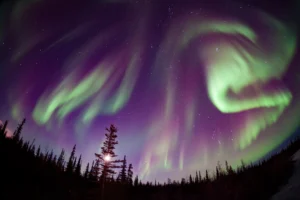
Why in News?
- Have you ever witnessed the night sky come alive with vibrant curtains of light? This mesmerizing phenomenon, known as the aurora borealis in the north and aurora australis in the south, has captivated humanity for centuries.
- But what exactly are these celestial light shows, and what ignites their brilliance? Let’s embark on a journey to unravel the science behind these dazzling displays.
The Aurora Borealis: A Collision of Sun and Earth
- Auroras, also poetically referred to as polar lights, are natural light displays that paint the night sky with vibrant hues of green, red, yellow, blue, and orange.
- These captivating curtains, spirals, and rays primarily dance across the high-latitude skies of the northern and southern hemispheres.
- While they’re most commonly observed near the Arctic and Antarctic circles, strong solar activity can sometimes push their reach to lower latitudes, making them visible from regions further south or north.
The Conductor Behind the Spectacle: The Sun’s Influence
- The key player orchestrating this celestial ballet is our very own Sun.
- Our star is a constantly active entity, spewing a stream of charged particles – primarily electrons and protons – along with magnetic fields, in a continuous flow known as the solar wind.
- As this charged wind races towards Earth, it encounters our planet’s magnetic field, which acts like a protective shield.
Breaching the Shield: Particles on a Collision Course
- While the Earth’s magnetic field efficiently deflects most of the solar wind, some charged particles manage to sneak through.
- These particles are channeled down the magnetic field lines converging at the North and South Poles.
- Here, they collide with the gasses present in Earth’s upper atmosphere, triggering a spectacular light show.
A Colorful Symphony: Unveiling the Colors of the Aurora
- The dazzling colors of the aurora depend on the specific gas molecules the energetic particles collide with.
- When these particles strike oxygen atoms, a vibrant green light is produced.
- Collisions with nitrogen molecules, on the other hand, unleash a spectrum of blues and purples.
- The intensity and composition of the solar wind thus determine the color palette of the aurora, creating a mesmerizing display that changes dynamically throughout the night.
The Power of the Storm: When Auroras Reach Lower Latitudes
- Auroras typically grace the high-latitude skies. However, during periods of heightened solar activity, the solar wind intensifies significantly.
- This can occur during solar flares and coronal mass ejections (CMEs) – bursts of charged particles and energy erupting from the Sun’s surface.
- When these powerful solar storms hit Earth’s magnetic field, they can trigger geomagnetic storms, causing temporary disturbances in the field.
- These intense storms can push the boundaries of the auroral zone, allowing the mesmerizing lights to be visible from lower latitudes.
A Recent Spectacle: A Geomagnetic Storm Lights Up the Sky
- A recent geomagnetic storm, triggered by a CME striking Earth, caused auroras to be visible across the globe.
- This “extreme” storm, as classified by the National Oceanic and Atmospheric Administration (NOAA), showcased the captivating auroras in regions like the United States, the United Kingdom, New Zealand, and Australia.
- Such storms, while visually spectacular, can also disrupt space-dependent technologies like GPS, radio communications, and power grids.
Conclusion: The Enduring Allure of the Aurora Borealis
- The aurora borealis and aurora australis are more than just breathtaking natural phenomena.
- They serve as a powerful reminder of the dynamic relationship between Earth and the Sun, and the unseen forces that shape our planet’s environment.
- So, the next time you have the opportunity to witness this celestial ballet, take a moment to appreciate the dazzling display and the fascinating science that unfolds before your eyes.
People also ask
Q1: What causes the aurora borealis?
Ans: The aurora borealis is caused by a collision of charged particles from the Sun, known as solar wind, with gasses in Earth’s upper atmosphere. These particles are channeled down the magnetic field lines converging at the North and South Poles, triggering the light show.
Q2: Why are there different colors?
Ans: The color of the aurora depends on the specific gas molecule struck by the energetic particles. Collisions with oxygen create vibrant green lights, while nitrogen unleashes blues and purples. The intensity and composition of the solar wind determine the ever-changing color palette.
Q3: When and where is the best time to see the aurora borealis?
Ans: The aurora borealis is most visible in the Arctic Circle during the equinoxes (spring and fall) when darkness and clear skies prevail. However, strong solar activity can make them visible at lower latitudes and throughout the year.
This is a topic that’s neaar to my heart…
Thank you! Where are your contact details though? https://lvivforum.pp.ua/
Thank you for your sharing. I am worried that I lack creative ideas. It is your article that makes me full of hope. Thank you. But, I have a question, can you help me?
Can you be more specific about the content of your article? After reading it, I still have some doubts. Hope you can help me.